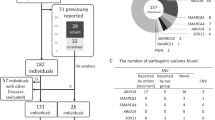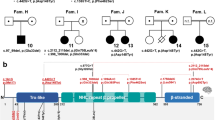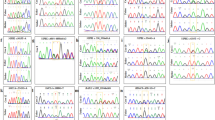Abstract
We found that a subject with Cockayne syndrome type A was a compound heterozygote for two new mutations in CKN1 (MIM 216400): a missense mutation (A205P) and a nonsense (E13X) mutation. We also identified and characterized a new common single nucleotide polymorphism in CKN1 in five groups.
Similar content being viewed by others
Introduction
Cockayne syndrome (CS) refers to a group of very rare autosomal recessive disorders with diverse developmental abnormalities, including cachectic dwarfism with a precociously senile appearance, microcephaly, skeletal and retinal abnormalities, sensorineural hearing loss, dental caries, characteristic ‘bird-like’ faces, hypogonadism, neurodysmyelination, and mental retardation (Lehmann 1987; Nance and Berry, 1992). Death results from progressive neurological degeneration, usually before age 20 (Lehmann 1987; Nance and Berry 1992). Most CS patients have increased skin photosensitivity but do not develop skin tumors, in contrast to patients with xeroderma pigmentosum (Lehmann 1987; Nance and Berry 1992). The molecular heterogeneity of CS was inferred from cellular complementation experiments (Lehmann 1987). Part of the CS phenotype is a significant delay in the recovery of DNA and RNA synthesis I cultured cells following exposure to UV light, which helped to define two distinct complementation groups, called CS-A and CS-B (Lehmann 1987). CKN1 (MIM 216400) encodes the WD-repeat protein that gives rise to CS-A activity (Henning et al. 1995), while ERCC6 (MIM 133540) encodes the CS-B protein. CS usually arises from mutations in either CKN1 or ERCC6, whose products remove UV-induced lesions in template strands of genes transcribed by RNA polymerase II (RNAP II) by a transcription-coupled repair (TCR) process (Svejstrup 2002). About 20% of mutations in Cockayne syndrome are in CKN1, which is also called ERCC8, and include four substantial coding sequence deletions, one nonsense mutation (T322X), and one missense mutation (Q106P) (Henning et al. 1995; Cleaver et al. 1999; Ren et al. 2003).
Methods
Study subjects
Cell line of CS proband
Lymphoblasts from CS subject AG07075 were obtained from the Coriell Cell Repositories (Camden, NJ, USA). The proband was an 11-year-old Caucasian girl with photophobia, dwarfism, mental retardation, cataracts, retinopathy, and optic atrophy (additional information can be found at http://locus.umdnj.edu/nia/nia_cgi/display.cgi?AG07075).
Normal controls
Samples from a DNA archive of 460 normal Caucasian subjects, 50 normal Chinese subjects, 50 normal South Asian subjects, 50 normal African subjects, 50 normal Amerindian subjects, and 50 normal Inuit subjects were used to determine frequencies of the CKN1 variants.
Cell culture and genomic DNA isolation
Lymphoblasts were cultured in minimal essential medium (Life Technologies, Rockville, MD, USA) supplemented with 20% heat-inactivated fetal bovine serum at 37°C in an atmosphere of 5% CO2 and 95% air. Genomic DNA from cultured lymphoblasts was obtained using a commercial method following the manufacturer’s instructions (Puregene, Gentra Systems, Minneapolis, MN, USA).
Screening CKN1 for genomic DNA variants
In order to amplify CKN1 coding regions and intron-exon boundaries from genomic DNA, primer sets were developed using NCBI sequences NT_006431 and NM_000082. Primers were each designed to anneal at 60°C, which allowed for use of a single amplification apparatus for all reactions. Amplification conditions were 94°C for 5 min, followed by 30 cycles comprised of 30 s each at 94°C, 60°C, and 72°C, ending with a single 10-min extension step at 72°C. All samples were directly sequenced on a Prism 377 Automated DNA sequencer (PE Applied Biosystems, Mississauga, ON, Canada).
Genotyping candidate gene polymorphisms
Rapid genotyping methods included: (1) detection of length of polymorphism by restriction endonuclease digestion followed by gel electrophoresis when a recognition site was altered, or (2) use of mismatched amplification primers to introduce a restriction site whose presence or absence was then dependent on the variant sequence. For the CKN1 A205P mutation, the exon 7 amplification primers and conditions were used (Table 1), and the resulting 294 bp product was incubated with endonuclease BseD1. The allele encoding A205 yielded a single 294 bp fragment after digestion, while the allele encoding P205 yielded two fragments with sizes 162 and 132 bp. For CKN1 E13X, the mismatched primer was 5’- GGT TTT TGT CCG CAC GCC AAA CGG GCC TG (with mismatched nucleotides underlined and in bold), and this was used with reverse primer 5’- ACT GGC CTG TTA GCC AAA AA. The 30 cycle amplification reaction was the same as above, except for a decrease in annealing temperature to 58°C. The resulting 106 bp product was incubated with endonuclease BstN1. The allele encoding E13 yielded two fragments with sizes 79 and 27 bp after digestion, while the allele encoding X13 yielded a single fragment of size 106 bp. For the CKN1 nt 471T>C single nucleotide polymorphism (SNP), the mismatched primer was 5’- CTG CAG ATG TAT TTA ATT TTG AGG AAA CAG TGT A (with mismatched nucleotide underlined and in bold) and was used with reverse primer 5’- AAA TTG TGA TAT TCC TCT GGG TT. The 30-cycle amplification reaction was the same as the general program, except for a decrease in annealing temperature to 58°C. The resulting 188 bp product was incubated with endonuclease RsaI. The 471T allele yielded a single fragment of size 188 bp after digestion, while the 471C allele yielded two fragments of sizes 156 and 32 bp.
Reverse transcription amplification and subcloning of CKN1
In order to determine the chromosomal phase of the two mutations found in subject NG070705, total lymphoblast RNA was isolated with the RNeasy Mini-kit (Qiagen, Mississauga, ON, Canada). First strand cDNA was synthesized from total RNA using an oligo-dT primer (Superscript First-strand Synthesis System, Invitrogen, Burlington, ON, Canada). Next, 2 μl of the first strand were amplified in a total of volume of 30 μl containing specific mRNA for CKN1 primers using GenBank accession number NM_000082. The forward primer was 5’-CGG TGT GAG GAC ACG ATA TG and the reverse primer was 5’-CAG CTT GTG ACT TTT TCC CA, spanning the coding sequence from exons 1 to 8. Thirty amplification cycles were performed at an annealing temperature of 60°C. The 726 bp PCR product was cloned into the pCR2.1 vector (TA Cloning kit, Invitrogen, Burlington, ON, Canada). After purification of plasmid DNA and EcoRI digestion, the positive clones were sequenced on a Prism 377 Automated DNA sequencer (PE Applied Biosystems, Mississauga, ON, Canada) using the above primer pair.
Statistical analysis
SAS version 6.12 (SAS Institute, Cary, NC, USA) was used for all statistical analyses. Chi-square analysis was used to test deviations of genotype frequencies from those predicted by the Hardy-Weinberg equation. The nominal level of statistical significance for all analyses was P<0.05.
Results
Identification of CKN1 mutations
We found that the study subject was heterozygous for CKN1 mutations c.73G>T (E13X) and c.649G>C (A205P). Subcloning of cDNA and sequencing indicated that these mutations were in a trans orientation on opposite alleles, indicating that the subject was a compound heterozygote. These mutations were completely absent from the genomes of 460 normal Caucasian, 50 normal Chinese, 50 normal South Asian, 50 normal African, 50 normal Amerindian, and 50 normal Inuit subjects (P<0.0000001). We found the common CKN1 c.471T>C SNP had 471C allele frequency of 0.27, 0.09, 0.17, 0.02, 0.02, and 0.07 in normal Caucasian, Chinese, South Asian, African, Amerindian, and Inuit subjects, respectively. This SNP is novel and is not present in the NCBI SNP database. None of the observed genotype frequencies deviated from the expectations according to the Hardy-Weinberg equation.
Discussion
We report: (1) primer sets that amplified CKN1 from genomic DNA and from reverse transcribed cDNA, (2) compound heterozygosity for two CKN1 mutations (E13X and A205P) in a cell line from a subject with CS, the seventh and eighth mutations reported to date, and (3) a common SNP in CKN1 and its frequency in five ethnic groups. Subject NG07075 is the second reported compound heterozygote for mutant CKN1 and A205P is the second reported missense mutation for this gene (Ren et al. 2003). While we have no functional data at present, the two CKN1 mutations from subject NG07075 are very likely to be pathogenic, since they are both completely absent from 710 normal genomes of individuals from various ethnic groups (P<0.0000001). Etiological relevance is also strongly suggested for the E13X mutation by its very early truncation and for the A205P mutation by virtue of its preservation in human, hamster, and mouse (data not shown). Codon 205 is within the third Walker repeat domain of CKN1 (Henning et al. 1995). The amplification primers and the common CKN1 c.471T>C SNP may prove to be helpful in future association and/or pharmacogenetic studies of developmental and/or aging related phenotypes.
References
Cleaver JE, Thompson LH, Richardson AS, States JC (1999) A summary of mutations in the UV-sensitive disorders: xeroderma pigmentosum, Cockayne syndrome, and trichothiodystrophy. Hum Mutat 14:9–22
Henning KA, Li L, Iyer N, McDaniel LD, Reagan MS, Legerski R, Schultz RA, Stefanini M, Lehmann AR, Mayne LV, Friedberg EC (1995) The Cockayne syndrome group A gene encodes a WD repeat protein that interacts with CSB protein and a subunit of RNA polymerase II TFIIH. Cell 82:555–564
Lehmann AR (1987) Cockayne’s syndrome and trichothiodystrophy: defective repair without cancer. Cancer Rev 7:82–103
Nance MA, Berry SA (1992) Cockayne syndrome: review of 140 cases. Am J Med Genet 42:68–84
Ren Y, Saijo M, Nakatsu Y, Nakai H, Yamaizumi M, Tanaka K (2003) Three novel mutations responsible for Cockayne syndrome group A. Genes Genet Syst 78:93–102
Svejstrup JQ (2002) Mechanisms of transcription-coupled DNA repair. Nat Rev Mol Cell Biol 3:21–29
Acknowledgements
Supported by operating grants from the Ontario Research and Development Challenge Fund (99-Sep-0507), the Canadian Institutes for Heath Research (MT13430), the Heart and Stroke Foundation of Ontario (NA3629), the Canadian Genetic Diseases Network, and the Blackburn Group. Dr. Hegele holds a Canada Research Chair in Human Genetics and is a Career Investigator of the Heart and Stroke Foundation of Ontario. Christina Williams was the recipient of a Heart and Stroke Foundation of Ontario Schultz award.
Author information
Authors and Affiliations
Corresponding author
Rights and permissions
About this article
Cite this article
Cao, H., Williams, C., Carter, M. et al. CKN1 (MIM 216400): mutations in Cockayne syndrome type A and a new common polymorphism. J Hum Genet 49, 61–63 (2004). https://doi.org/10.1007/s10038-003-0107-2
Received:
Accepted:
Published:
Issue Date:
DOI: https://doi.org/10.1007/s10038-003-0107-2
Keywords
This article is cited by
-
Multimodal imaging in a family with Cockayne syndrome with a novel pathogenic mutation in the ERCC8 gene, and significant phenotypic variability
Documenta Ophthalmologica (2020)
-
Molecular spectrum of excision repair cross-complementation group 8 gene defects in Chinese patients with Cockayne syndrome type A
Scientific Reports (2017)
-
Cockayne syndrome type A: novel mutations in eight typical patients
Journal of Human Genetics (2006)
-
Characterisation of novel mutations in Cockayne syndrome type A and xeroderma pigmentosum group C subjects
Journal of Human Genetics (2005)



